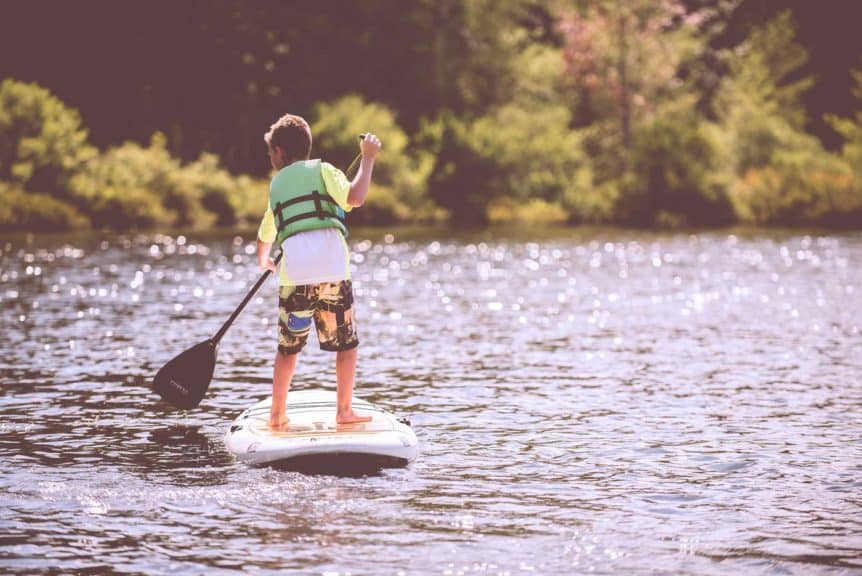Jesus walks on water. It’s one of the most famous stories from the Gospels! Use this lesson to teach kids what this story means about where we should place our faith.
Editor’s Note: This lesson was adapted from Bible-in-Life, Upper Elementary.
Scripture:
Matthew 14:22-33
Focus:
We can have strong faith in Jesus.
Supplies:
- Brain Strain Puzzles: Brain Strain Puzzles
- Studying God’s Word: Bibles; Walking on Waves Bible Study
- Impossible Assignment: Bibles; Impossible Assignment Activity Sheet; Pencils
- Illustrations: Walking on Waves Bible Study; Bibles; Drawing paper; Markers; Pencils
- Storms: Clear plastic container; Pitcher of water; Drinking straw for each child; 1 1/4″ clip-on fishing bobbers or objects that float; Plastic tablecloth; Bibles
- Applying God’s Word: The Faith Wellness Plan Activity Sheet; Markers; Two small paper plates per student; Cardboard strips 1 x 12 inches; Glue sticks

Jesus Walks on Water Bible Background
The Sea of Galilee is known for its sudden, violent storms. The surface of the Sea of Galilee is 680 feet below sea level, surrounded by steep cliffs and hills.
The air over this body of water, heated by the sun, rises. As it rises, the cool air rushes down the hills and across the water with great force, causing extremely dangerous storms.
One such storm is central to today’s lesson.
The disciples sailed during one of these storms. After several hours of being “buffeted by the waves” (Matt. 14:24), it was early morning, the fourth watch (Matt. 14:25).
The Romans divided the 12 night hours into four watches with the fourth watch being from 3:00 to 6:00 a.m. The parallel account in John’s Gospel indicates that the disciples were three to four miles off shore.
The disciples’ fear made them vulnerable to superstition, and they thought the figure walking toward them was a ghost (Matt. 14:26). Jesus quickly identified Himself and told them to not be afraid.
God interrupted the laws of physics by allowing Peter to walk, by faith, on the water’s surface. But when Peter looked down and noticed the wind buffeting the waves, he again became scared and started to sink.
Peter had much to learn. Many times he failed, but Peter came out of each failure with more faith and strength.
Early Bird Options
Activity 1: Who Is Strong?
Let your students share their opinions about people they think are strong. Write the questions “What makes a person strong?” and “Who is strong?” on the board and let students respond.
Let them vote for the person they think is the strongest.
Activity 2: Brain Strain Puzzles
Supplies:
Separate the “Brain Strain” puzzles and spread them out on a table. Let students try to solve the puzzles.
Connecting with God’s Word
To help students start thinking about trust, they will do an activity and discuss trusting others.
This week’s Bible study from Matthew 14:22-33 examines the account of Peter walking on the water to Jesus and how his initial faith faltered.
To help your students begin thinking about what it means to trust and to connect to the Bible study, lead them in the following trust fall activity.
Ask for two volunteers. Have one student stand two feet behind the other. Explain to the student in front that he or she needs to trust, or have faith in, the person behind.
Before explaining what the students are going to do, ask the student in front if he or she trusts the person behind them. (The student will likely say yes, especially if the two students know each other.)
Then explain to the front person that he or she is to stand stiffly and start to fall backward into the arms of the person behind him or her.
Note: Make sure that you serve as a spotter by standing slightly behind the two students, and hold out your arms behind the student catching the falling person.
If the first student is reluctant to fall, you could offer to catch him in place of the second student doing so.
You will find that many students will start the process but may bend their knees at the last minute or take some other action to catch themselves.
If other students indicate an interest in trying the trust fall, you could give a few others an opportunity as your time allows. Again, make sure to act as a spotter with each pair.
After the students have completed their trust fall, gather them as a group and help them connect the activity with the Bible study by asking:
- How much did you have to trust the person catching you if you were doing the trust fall? (Allow both those who participated in the trust fall and those who watched to answer. The students who actually “took the fall” must have had at least a little trust to start the process. Those who allowed themselves to fall all the way must really have trusted the person who caught them.)
- What makes it hard to trust someone else? (If the person has failed or hurt you before, it can be hard to trust again; if you don’t think the person is really able to do what it takes to help; if you’re not sure the person really knows what he’s doing, etc.)
As we saw with our trust fall activity, sometimes it can be really hard to truly trust another person! We may think we trust him or even say we trust him, but until it’s put to the test we don’t really know.
Another term for trusting someone is having faith in that person. In our Bible study today, we’ll see how one of Jesus’ disciples “stepped out” in faith!
Studying God’s Word
Using the Bible and Bible Adventures, students will study Matthew 14:22-33, in which Peter walks on the water with Jesus.
Supplies:
Give each student a Walking on Waves Bible Study sheet. Ask students to locate Matthew 14:25-33 in their Bibles so that they can see where today’s Bible study comes from.
Then read aloud the introduction to the Bible study, reprinted here: Jesus had just finished feeding the five thousand. After He sent the disciples across the Sea of Galilee in their boat, He went back up onto the mountainside to pray. While the disciples’ boat was far from the shore, the strong wind caused the waves to pound against it.
Point out the footnote about storms on the Sea of Galilee. You could have a student look up John 6:16-21 in the Bible and hold that place open.
Ask for a volunteer to read the first Scripture Spotlight (Matt. 14:25-27).
The student who looked up John 6:16-21 can read it now.
Students may also be interested to note that the parallel account in John’s Gospel (see 6:19) indicates that the disciples were about three or four miles from shore, so Jesus probably walked all that way on the water.
- How did the disciples react when they saw Jesus? (They were scared because they thought Jesus was a ghost.)
- What did Jesus say to help them with their fear? (He told them that it was Him walking toward them and not to be afraid.)
Choose a few volunteers to read the second Scripture Spotlight (Matt. 14:28-30) from Walking on Waves Bible Study.
- What does Peter’s statement to Jesus tell you about him? (Peter seemed to display more courage than the others. He was ready to believe it was Jesus and go meet Him.)
- What do you think Peter needed when he walked on the water? (Allow your students to wrestle with this question. Guide your students to see that Peter demonstrated great faith in just stepping out of the boat.)
- Why did he begin to sink? (Help your students understand how Peter quickly realized that people “can’t” walk on the water, and he replaced his faith with paralyzing fear.)
Ask a volunteer to read the next Scripture Spotlight section, Matthew 14:31-33, from the Bible.
- What did Jesus say to Peter? (In essence, He said: “Your faith is so small. Why did you doubt Me?”)
- How do you think Peter felt about Jesus’ words? (Encourage students to think about how they would feel under the circumstances. Scripture actually doesn’t say for sure, but Peter may have felt ashamed that he didn’t trust Jesus more. He may have wondered why Jesus said what He did because Peter at least stepped out of the boat. He may have been embarrassed because the other disciples had seen him fail.)
Have a student read the last paragraph (starting with “Peter took a . . .”) before you discuss the last couple of questions in the study.
- From what you know about Peter, what advice might he give us, based on his experience? (He would probably say that we can do great things with God’s help, and that just as his faith grew stronger over time, we, too, can have strong faith in Jesus.)
- How can we develop a strong faith in Jesus? (Let students wrestle with this. Help them brainstorm ways Christians can grow in their faith: Bible study; prayer; good teaching from wise, godly Christians; and making a point to trust Jesus more and more as we see how He meets our needs and cares for us.)
Interacting with God’s Word
Students will reinforce the Bible lesson by exploring what it means to have strong faith in Jesus.
In the Bible study today from Matthew 14:22-33, your class saw how Peter’s faith led him to walk briefly on the water with Jesus.
Students learned that they can have strong faith in Jesus. Each activity below will reinforce that message in a slightly different way. Use as many of these choices as possible, allowing students to choose among them.
Activity 1: Impossible Assignment
Supplies:
- Bibles
- Impossible Assignment Activity Sheet
- Pencils
This worksheet will help students discover other Bible people who faced impossible situations but through faith in God, came out victorious.
Have students look at the Impossible Assignment activity sheet and read the clues to complete the puzzle. Students can look up the people in their Bibles (Scripture references are listed) if they need additional help.
Answers: 1A: Daniel; 1D: David; 2D: Lion; 3A: Alive; 4A: Noah; 5A: Red Sea; 6D: Elijah; 7D: Giant; 8D: Water; 9D: Moses; 10A: Flood; 11A: Joshua; 12A: Jericho; 13A: Peter
- How did the faith of these people in the Bible help them through seemingly impossible times?
Activity 2: Illustrations
Supplies:
- Walking on Waves Bible Study
- Bibles
- Drawing paper
- Markers
- Pencils
This illustration activity helps your students reinforce today’s Bible study through drawing pictures of events in the story. Students can choose a scene from the story and illustrate it.
If you have a group working together, you might encourage each child to choose one part of the story and draw it so that you have the entire narrative drawn in sequence.
Encourage them to write on their drawing today’s Lesson Focus: We can have strong faith in Jesus.
When the students finish, be sure to display their artwork.
- Why did you choose that part of the story to illustrate?
Activity 3: Storms
Supplies:
- Clear plastic container
- Pitcher of water
- Drinking straw for each child
- 1 1/4″ clip-on fishing bobbers or objects that float
- Plastic tablecloth
- Bibles
Let your students explore Bible verses to help them in life’s storms.
Before class, use a permanent marker to write the following references on the bobbers or floating objects: Psalm 46:1; Philippians 4:13; John 3:16; Romans 8:31-32; Psalm 118:6-7; Isaiah 40:29-31; Jeremiah 29:11. Add other verses that have special meaning to your class.
During the lesson, set the plastic container on the tablecloth, pour the water in, and float the objects.
Let students name a “storm” in their lives and blow on the water.
Have them talk about how the objects in the water don’t sink.
Let the students take out the floating objects, look up the Bible verses, and talk about how that verse can help in one of life’s storms.
- How can each verse help you when you have a “storm” in your life?
When the time you have allotted is up, ask your students to clean up the materials and gather back together.
Applying God’s Word
To help them take the lesson home with them, students will make a faith fitness barbell as a reminder to put into practice a faith fitness plan.
Supplies:
- The Faith Wellness Plan Activity Sheet
- Markers
- Two small paper plates per student
- Cardboard strips 1 x 12 inches
- Glue sticks
After you have given students time to clean up from their various activities, gather them into a single group.
Hand out The Faith Wellness Plan activity sheet.
Summarize the events of today’s lesson by saying something like: Peter had strong faith when he stepped out of the boat, but it weakened when he saw the waves. Like Peter we all need to exercise our faith muscles to have the strong faith Jesus wants us to have.
Encourage them to examine the ways listed that they can strengthen their faith (“Watch Your Diet,” “Exercise Those Faith Muscles,” and “Get Proper Rest”).
Under “Exercise Those Faith Muscles,” point out the last question (“Think of three difficulties”). Let students spend a few moments coming up with three problems.
Give students two small paper plates and a cardboard strip (prepared before class, if possible) and have them write the three problems they named on the back of their paper plates.
Then have students write the Lesson Focus: “We can have strong faith in Jesus” on the cardboard “bars.” They can personalize the focus by replacing the word “We” with “I.”
Have students glue the bar to the two paper plates to make barbells.
Gather students together with their faith barbells. Encourage students to fill out their faith wellness plans at home and use the methods listed on The Faith Wellness Plan activity sheet to strengthen their faith during the week.
Have students think about which spiritual area they need to exercise most, and let them pray silently while pumping their barbells.
Close in prayer, thanking God for the ways He strengthens our faith. Pray for each student individually, if possible, and ask that God help him or her to have strong faith in the coming week.
Seeing God Throughout the Week
Remind students to exercise their faith. Acknowledge that sometimes it’s hard to have a strong faith in Jesus. Encourage students to ask God for help to rely on Jesus’ strength all the time.

Did you enjoy this lesson? It was adapted from Bible-in-Life for kids. To learn more about this curriculum, check out the video below or visit BibleinLife.com.
Explore every age level at BibleinLife.com!
Need more lesson ideas? Try these!
How to Make Sure your Bible Lessons Make a Difference in Kids’ Lives






